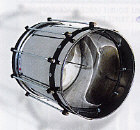Phil Little's recent album, Samba Olimpicos, features many of the patterns on this website.
Starting Up A band ?
If you would like to start a Samba
percussion Group or indeed any kind of Percussion Group and you don't know how
to go about it see our Start
Up page.

for Samba Instruments by Gope,
Bauer, Remo, RMV, etc.

We recommend Drumap for stunning Samba arrangements
Cuica

Purchase
Cuica
The sounds from The Cuica are produced by
rubbing a damp cloth along the stick inside the drum. The cloth is held around
the stick by the thumb, index and middle finger of the right hand. The left
hand helps to hold the drum which hangs from a strap around the shoulder or
neck or a harness. Short sharp strokes produce higher pitched notes and Slow
long strokes produce lower pitched notes. Pitch can also be controlled by pinching
the rod tighter and/or by pressing the thumb or fingers of the left hand onto
the head, close to the centre.
The cuica is an individual
sounding instrument and is usually improvised although there are several standard
patterns that can be used as a basis to launch improvisations and a haven to
return to when it gets a bit frantic.
KEY U = Up
ie.
Towards the Head D = Down
ie. Away
from the Head
The first pattern is a good one for
practising.

Then try this Samba phrase which should
sound familiar.

Some patterns relying more heavily on the off
beat

and

and

and

Here is an interesting and humorous
description of the different sounds that can be made on the Cuica and the
techniques employed to achieve them. It is authored by Matthew Dubuque (e-mail mdubuque@yahoo.com
).
One's approach to cuica playing can not
be taken too seriously.
It is best to play the smallest cuica you can find. They squeal
more, contributing greatly to what is known as "the distressed
hamster" effect.
One should first understand basic samba rhythms when plaything the
instrument. Many excellent grooves are found simply by omitting various notes of
this samba motif. The motif supplied by Trevor Salloum in his bongo
instuctional books is not horrible.
One of the raisins why I like the cuica is that there are no players
allowed into recording studios at present (this could change) who feel that
playing a guaguanco rhythm on the cuica is somehow appropriate.
I find this deeply reassuring, a tranquil refuge from the guaguanco
hegemons and their hackneyed ways.
The cuica can be described as the mockingbird of musical instruments. You
may use the cuica in your playing to alternate among various animal sounds.
One of my favorite cuica solos is on a very rare Bola Sete album (not
available on CD yet) played by yes, you guessed it, Armando Peraza. (92 year
old Master Percussionist formerly with Santana - Ed.)
In this cuica solo, Armando really seems to master a wide range of animal
voices. For example, he starts the solo off with a series of low,
vibrating growls which sound like a menacing dog with just a fine
hint of a snarl, similar to the finish on a fine wine.
(Note that it is only possible to obtain this sound with the fingers of
your other hand NOT pressing in on the drum head. You need as deep a tone
as possible for this.)
Armando then proceeds to the well-known warning cries of a furious
rhinocerous. All that is missing is the foot-stomping which usually
accompanies these displays in the wild or in zoos where captive rhinos
have been forced to listen to endless tape loops of Marisleysis Gonzales
wailing and moaning and describing her love for her "little Elian".
This "rhino fury" sound is difficult to master and can best be
produced by only stroking the internal cuica stick AWAY from the head to produce
the series of pure, unwavering squeals necessary to imitate
this emotion.
The short solo then reaches it's inevitable Peraza climax when Armando
launches into a "terrified hamster squeal" mode.
These hamster squeals sit on that quintessential 3-dimensional cusp
between (among?) sounding intolerably bizarre, unbelievably hilarious and
strangely evocative of the universal suffering of small,
irrelevant animals everywhere.
These extremely high pitched noises are produced by very short and rapid strokes
on the part of the stick closest to the cuica head, while simultaneously
depressing the center of the drum with the other
hand.
CONCLUSION
As you can see, the cuica is a very versatile instrument. You can
use it in large gatherings ranging from a gathering of Midwestern Republican
party faithfuls to your local raves; the cuica has a very
broad appeel in deed.
I am starting to learn to play the cuica in a new way. In one hand I
play a large cuica and with the other hand I play a very small (around 7-inch)
one.
I tune them a fifth apart. By playing two cuicas at once, I now have
a little portable animal symphony.
Stranded among the eaters of American red meat,
I remain
Matthew Dubuque
If you would like to start a Samba
percussion Group or indeed any kind of Percussion Group and you don't know how
to go about it see our Start
Up page.
I hope that you have found some of this
useful. Let me know! Come back soon to check for updates.
E-mail
phil@littledrum.co.uk
To return to main page click, HOME
All the material on this site is Copyright
Phil Little 2002








